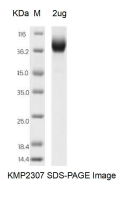Service Line:+86-022-82164980
Address:FL-4, Building A5, International Enterprise Community, Tianjin, China
Email:[email protected]
| Catalog Number | KMP2307 |
|---|---|
| Product Name | Human CD226 Protein, Fc Tag |
| Product Description | The Human CD226 Protein(KMP2307) is produced in HEK293 Cells and the target gene encoding Glu19-Asn247 is expressed with a Fc tag at the C-terminus. |
| Molecular Weight | 26.01 kDa |
| Alias | CD226 antigen, CD226 |
| Species | Human |
| Host | HEK293 Cells |
| Size | 50ug, 100ug, 200ug |
| Purification | Affinity purification |
| Purity | >95% as determined by SDS-PAGE |
| Endotoxin | <1.0 EU/ug determined by the LAL method |
| Buffer | PBS, pH7.4 |
| Uniprot | Q15762 |
| SDS-PAGE |  |
| Function | Involved in intercellular adhesion, lymphocyte signaling, cytotoxicity and lymphokine secretion mediated by cytotoxic T-lymphocyte (CTL) and NK cell (PubMed:8673704). Cell surface receptor for NECTIN2. Upon ligand binding, stimulates T-cell proliferation and cytokine production, including that of IL2, IL5, IL10, IL13, and IFNG. Competes with PVRIG for NECTIN2-binding (PubMed:26755705). |
| Background | Human DNAX accessory molecule 1(DNAM-1/CD226) is a 65 kDa type I transmembrane glycoprotein in the immunoglobulin superfamily. Mature human DNAM-1 contains an extracellular domain(ECD) with two Ig-like C2-set domains and a cytoplasmic region that contains motifs for binding PDZ domains and band 4.1 family proteins. DNAM-1 is expressed on multiple lymphoid and myeloid cells and interacts with CD155 and CD112. Ligation of DNAM-1 promotes the activation of NK cells, CD8+ T cells, and mast cells, dendritic cell maturation, megakaryocyte and activated platelet adhesion to vascular endothelial cells, and monocyte extravasation; it inhibits the forrmation of osteoclasts. Plateletendothelium, interactions mediated by DNAM-1, enable the metastasis of tumor cells to the lung. |
| Storage | Aliquot and store at -20℃ to -80℃. Avoid repeated freezing and thawing cycles. |
| Note | This product is for research use only. |
| References | 1.J. Exp. Med. 213:167-176 (2016) 2.Immunity 4:573-581 (1996) |